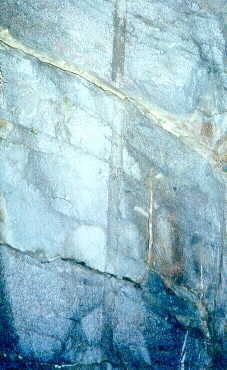|
|
|
|
The procedure involves the
installation of an inflatable or mechanical packer which is placed in
the well bore at least 20 feet below the casing and drive shoe seal
and at least 60 feet below the ground surface to insure that the
process does not "break" the seal or allow surface water contaminants
to enter the well. The packer is inflated or locked into position and
water is pumped through the packer under pressure. Most applications
require between 500 and 2000 pounds per square inch (psi) and in some
cases 3000 psi pressure may be needed in tight rock formations.
Examples If successful, pressure will steadily rise to a maximum level as the rock formation resists flow, then will suddenly drop off and stabilize at a lower pressure. The drop in pressure indicates that the formation is accepting water and the resistance to flow is diminished. Water is pumped into the formation for 5 to 30 minutes. Injection pump delivery rates of 50 to 75 gallons per minute (gpm) have proven successful. Generally, 1500 to 2000 gallons of water are pumped into the bedrock formation. Continued...
Example of
Bore Hole and Fractures.
It is extremely important that
only clean, disinfected water is used for injection water because of
the extreme pressure involved and the potential for forcing
contaminants deep into the bedrock aquifer. One or two packers may be
used for hydro-fracturing. When utilizing one packer, it is set near
the top of the well but at a minimum safe distance below the drive
shoe. After the initial frac sequence, the packer is deflated or
unlocked and lowered further into the hole and the process is repeated
as many times as necessary. Commonly two sequences are performed. Zone fracturing utilizes a
two packer system where the packers in series and water is pumped into
the zone between the packers. This system can be more effective
because it concentrates pressures within a small area, typically 30 to
60 foot intervals, and individual fractures can be isolated and
hydraulically fractured. With this method, the procedure starts within
a specified section of the well targeted by the water well contractor.
Each successive sequence stresses one interval higher than the last.
In this way, all potential water bearing fractures or fracture zones
are worked independently within the section being hydro-fracked. This
differs from, the single packer, one or two frac sequence method which
probably only affects the weakest, least resistant point(s) in the
well but still may produce adequate results for private wells serving
individual households. Zone fracturing is more expensive and time consuming procedure and is generally used only on difficult wells or public supply wells or if a larger flow of water is desired.
Click Here For
Hydro-Fracturing Diagrams Home | Hydro-fracturing | How it Works | Yield Testing | History Location | Contact Us |
|



